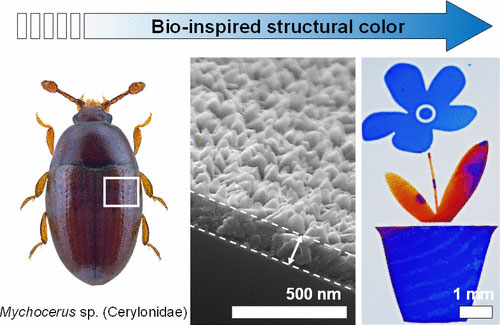| Posted: Jun 14, 2017 |
Beetles spark development of color-changing nanoparticles for commercial use
(Nanowerk News) Inspired by the varying colors that gleam off of beetle shells, scientists have developed color-shifting nanoparticles that can change hue even after being embedded into a material.
|
|
A report on the new, inexpensive technique, which could lead to the production of easier-to-read sensors and anti-tampering tags, appears in ACS Applied Materials & Interfaces ("Bioinspired Structural Colors Fabricated with ZnO Quasi-Ordered Nanostructures").
|
 |
| Creating colors by copying beetle nanostructures could find applications in dyes, inks and sensors. (Image: American Chemical Society)
|
|
The shells, or exoskeletons, of beetles are covered with stacks of crystalline-like shapes that scatter light and produce dazzling colors. In some cases, these colors can change with just a slight shift of the viewing angle. Known as structural colors, scientists have long been interested in replicating them for use in paints, dyes, cosmetics and other products.
|
|
But unlike many pigments, structural colors are eco-friendly and resist fading. Current techniques used to integrate structural colors into materials are time-consuming and costly, however. And once they are attached to a surface, it is hard to modify them. Geon Hwee Kim, Taechang An and Geunbae Lim sought to overcome these challenges.
|
|
The researchers used a process called hydrothermal growth to synthesize zinc oxide nanostructures in 40 to 80 degree Celsius water. This technique produced the tiny particles quickly and easily.
|
|
The method also allowed them to better control the size and spacing of the nanostructures, a key step toward being able to adjust colors as needed within a material or fabric.
|
|
The researchers conclude that this new technique could have broad applications including the fabrication of microelectrodes for use in sensors.
|

